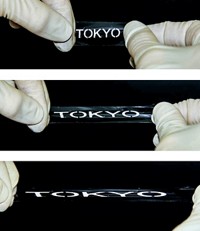Advertisement
Grab your lab coat. Let's get started
Welcome!
Welcome!
Create an account below to get 6 C&EN articles per month, receive newsletters and more - all free.
It seems this is your first time logging in online. Please enter the following information to continue.
As an ACS member you automatically get access to this site. All we need is few more details to create your reading experience.
Not you? Sign in with a different account.
Not you? Sign in with a different account.
ERROR 1
ERROR 1
ERROR 2
ERROR 2
ERROR 2
ERROR 2
ERROR 2
Password and Confirm password must match.
If you have an ACS member number, please enter it here so we can link this account to your membership. (optional)
ERROR 2
ACS values your privacy. By submitting your information, you are gaining access to C&EN and subscribing to our weekly newsletter. We use the information you provide to make your reading experience better, and we will never sell your data to third party members.
Materials
Aligning Nanowires For Transparent Electrodes
Materials Science: Printing method lines up silver nanowires for more transparent, flexible electrodes
by Katherine Bourzac
December 7, 2015

A new method prints highly transparent, silver nanowire electrodes in one step. These electrodes could be particularly useful for flexible electronics, such as display touchscreens (Nano Lett. 2015, DOI:10.1021/acs.nanolett.5b03019).
Transparent, flexible electrodes will be part of fully flexible devices of the future, such as cell phones that can be rolled up, or displays that can be applied like cling film to any surface. Even today, such electrodes would have advantages in portable electronics, replacing the standard transparent electrode material—brittle indium tin oxide on glass—with electrodes on plastic and other materials that won’t shatter when you drop your phone. Silver nanowires offer transparency and can be readily printed on flexible substrates.
With silver nanowire electrodes, there’s a tradeoff between transparency, which ensures a good-looking display, and conductivity, which ensures a well-functioning touchscreen. Many researchers have developed various tricks for improving the conductivity of sparse nanowire arrays—for example, by scattering the nanowires using simple printing methods, then fusing them together with heat or pressure. Hyunhyub Ko, a chemical engineer at the Ulsan National Institute of Science & Technology, wanted to get good transparency and conductivity in one step.
Ko developed a simple way to align the nanowires. First the researchers coat a surface with a suspension of the 20 to 30 μm-long wires in ethanol. Then they drag a rubbery polydimethylsiloxane stamp over the surface. The stamp is patterned with channels that align the nanowires like a hairbrush smoothing messy tresses. As the solvent evaporates from the printed nanowires, capillary forces further align them. The alignment encourages the flow of electrons between wires, boosting overall conductivity while allowing the nanowires to be relatively sparsely distributed. This sparseness improves transparency: An organic light-emitting diode made with the new material is 30% brighter than one made using a randomly aligned silver nanowire electrode. But the randomly aligned electrodes still have slightly higher conductivity than the aligned ones.
L. Jay Guo, an electrical engineer at the University of Michigan, says he would like to see the group eliminate the tradeoff in conductivity. Ko is working on scaling up the printer system from the current 2 cm-long print head to a much wider one, which will increase the throughput.





Join the conversation
Contact the reporter
Submit a Letter to the Editor for publication
Engage with us on Twitter